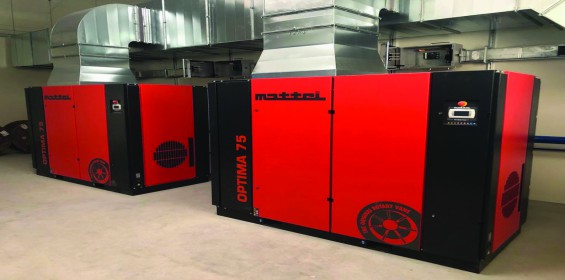Are ‘oil-free’ compressors a myth?
Published: 17 April, 2019
When purchasing new compressors, an increasing number of factory managers are stipulating ‘oil-free’ and ‘class zero’ requirements as part of the specification process. However, research shows that these products can be less energy efficient and cost more to maintain than oil-lubricated equivalents. Andy Jones, managing director at Mattei, considers how oil-free air can best be achieved.
A recent report into the global air compressor market has found that the oil-free segment now holds the largest share of the market and will grow at a faster rate than its lubricated counterpart. These trends are driven by the fact that some compressed air users believe that oil-free options offer improved air quality, as well as reduced costs for purification equipment and maintenance.
Historically, it was only the most sensitive of environments, such as pharmaceutical and food and drink manufacturing, that required compressed air to have such a high standard of purity. This was for compliance with regulations allowing only trace amounts of residual oil in their air.
Today, however, ‘oil-free’ has almost become a buzz word and machines that don’t use any oil at all are being hailed as the optimum solution in many more industry sectors. The problem is that there are many myths surrounding oil-free compressors and the quality of air they deliver, including the assumption that the air is totally oil-free.
So, what is the case for oil-free compressors, and should factory managers be looking for alternative solutions to achieve their objectives?
Assessing the standards
One of the main myths surrounding oil-free compressors is that they do not use oil. Let’s take a look at this in more detail. The international standard for compressed air quality (ISO8573-1:2010) specifies the amount of contamination allowed in each cubic metre of compressed air. Contaminants are separated into three areas – solid particulate, water and oil – each having a range of classes (one to nine).
When specifying the purity of air required, a purity class is selected for each of these three contaminants respectively. Purity class 1 states that in each cubic metre of compressed air not more than 0.01mg of oil is allowed. Meanwhile, class 0 (zero), despite its name, does not mean zero contamination. In reality, class zero simply has to have less contamination in a cubic metre of air than class 1.
By design, oil-free compressors do not use oil in the compression chamber and therefore oil does not contact the air being compressed. However, oil is often used for the lubrication of moving parts and cooling of the machine. Given that ‘oil-free’ compressors are not completely oil-free, factory managers should consider whether class 1 or class zero for oil is truly needed.
Cost savings
It is often stated that using an oil-free compressor reduces the user's overall cost of ownership as costly filters can be eliminated, as is the need to change filter elements. System pressure losses are also slightly reduced, again lowering costs.
However, purification equipment is still necessary to stop contaminants entering through the compressor intake. For example, contaminants within the atmospheric air or added by the compressor itself, along with rust and pipescale in the compressed air system, mean that no matter what type of compressor is installed, the same level of purification equipment is required.
The cost could be high too, if the elaborate and complicated sealing mechanism which is used to prevent the lubricating oil from entering the compressed air, fails. Therefore, air from oil-free compressors require the same level of careful filtration as lubricated compressors to remain compliant and avoid significant downtime as well as waste. This negates the argument of lower overall cost of ownership.
Typically, the purchase price of an oil-free compressor is 45 to 50% higher than that of an equivalent lubricated compressor. Maintenance of the air end is generally more frequent than lubricated equivalents, and in some models, complete replacement of the air end is required after only a short number of years, which actually increases the overall cost of ownership significantly.
It is also worth noting that the higher the quality of the compressed air, the higher the cost of producing it. We often find factories using oil-free compressors to provide all of their air requirements, when actually only a small part of their process requires such high levels of purity. This requirement could be addressed by point of use filtration, or if absolutely required, a smaller local point of use oil-free compressor with filtration.
Efficient alternatives
Advances in oil filtration technology mean that lubricated compressors can sufficiently meet stringent air purity standards - as well as provide a more functional and cost-effective choice.
Lubricated, rotary vane compressors are exceptionally durable and around 15% more energy efficient. Typically, oil-free machines will absorb more power than oil-lubricated compressors, making the latter more economical to operate. This is because oil retains heat during compression, which increases performance efficiency. Oil acts as a coolant, and in a lubricated compressor it removes around 80% of the heat produced during air compression.
The myth we often hear is that if you don’t use oil you will be more environmentally friendly, but this is more than negated by the higher energy consumption required to run an oil free compressor compared to an oil-lubricated compressor.
Despite the market for oil-free compressors continuing to expand, in many cases a compressed air system combining lubricated vane compressors with high quality dryers and filters offers the best value and performance. The myths surrounding oil-free compressors have created an inflated market when filtration will often suffice.
For further information please visit: www.mattei.co.uk







